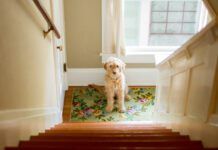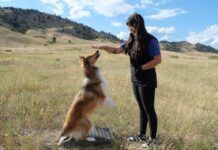Separation anxiety (SA), also known as separation-related distress, is one of the most common behavioral problems in pet dogs with some estimates stating that one in four dogs will suffer from separation anxiety during their lifetime.
What is Separation Anxiety in Dogs?
Separation anxiety occurs when a dog is unable to cope with separation from their human caregiver or canine companion. It can range in severity from relatively mild through to extreme.
According to a recent study by Beaver (2024) up to 85.9% of dogs displayed moderate to serious separation-related behaviors. This finding demonstrates the emotional impact isolation can have on dogs, many of whom are ill equipped to cope with separation.
Many dog owners don’t realize that the ability to cope with separation from attachment figures is a learned behavior and a skill we must gradually teach our dogs, just like we teach it to our babies and young children.
How To Recognize Separation Anxiety in Your Dog
There are a number of signs to look for which could indicate your dog is experiencing separation anxiety. In mild cases, the signs might be quite subtle and easily missed whereas in moderate to extreme cases, the signs will be very obvious.
Signs of separation anxiety include:
- Panting
- Pacing
- Drooling
- Increased heart rate
- Excessive whining or barking
- Not eating when alone
- Destructive scratching and/or chewing
- Trembling
- Sweaty paws
- House soiling
- Attempting to escape from the home or backyard
If you notice any of these signs in your dog when she is left alone it’s important to make an appointment with your vet to confirm a separation anxiety diagnosis or rule it out. Some signs of separation anxiety, such as excessive barking, destructive chewing and attempting to escape the home, can be the result of boredom or even linked to a medical issue.
Common Triggers for Separation Anxiety in Dogs
Separation anxiety can be triggered by several different events or circumstances which are typically related to a change to the normal routine. These can include:
- Going to a new home as a puppy
- Being left alone for the first time
- Being surrendered to an animal shelter
- Being adopted from an animal shelter
- Moving house
- Changes to the owners work schedule
- A family member moving out
- The owner traveling
- Staying at a boarding kennel (especially for the first time)
- A death in the family
Curing Dog Separation Anxiety Quickly
Most dog owners want to know how to cure separation anxiety quickly. However, the reality is that there are no quick fixes. Overcoming separation anxiety takes time, patience, and consistency in terms of management and training.
Prevention is the best cure. Teaching your puppy how to cope with separation gradually and to associate it with positive experiences will help prevent them from developing separation anxiety. However, if your dog already has separation anxiety, you can still help them overcome it.
How To Help a Dog with Separation Anxiety
The first step to helping a dog with separation anxiety is to make an appointment with your vet or a qualified behaviorist. They will determine the severity of the separation anxiety, whether anti-anxiety medication is recommended for successful treatment, and provide you with a training and management plan to work to resolve the separation anxiety.
When separation anxiety is on the moderate to extreme end of the scale, medication can be very beneficial to help facilitate behavior modification. This is because the medication can reduce the anxiety enough to allow learning to occur. Without it, behavior modification may not be successful as highly anxious dogs are often unable to learn and retain information.
Dog Separation Anxiety Training
There are a number of training exercises that can be done to help a dog with separation anxiety. Let’s look at how dog separation anxiety training looks in both the short and long term.
Short term management and training
Here are some short-term management and training techniques that can help to reduce separation anxiety:
- Avoid leaving your dog home alone. The aim is to avoid any further negative experiences with being left alone while simultaneously working to teach your dog to associate separation with positive experiences.
- Start to teach your dog that being separated from you within the home can be a pleasurable experience. You can do this using a sit-stay exercise where you ask your dog to sit, then say “stay”. Next, take a step away, wait three seconds and step back toward your dog. If they maintained the sit, say “good girl/boy” and immediately reward with a high value treat. Repeat several times. If your dog succeeds and does not break the stay gradually increase the distance and duration that you move away from them, building up so that you can move out of sight for longer periods of time. It’s important that you reward them every time they succeed. If at any point they break the stay it means your dog is not coping at that level. Go back to the previous step at which they were successful and continue to build from there. Practice in different rooms of the home and in the backyard. With time and consistency your dog will learn that being separated from you can be a positive experience.
- Feed your dog their meals in a room or area away from you. This also teaches them that being separated from you can be a pleasant experience as they are associating separation with their meal (a primary reinforcer). You can also give them high value chew treats, a lick mat, or treat puzzle toys during the day to help them learn associate separation with pleasurable experiences (eating high value treats).
Long term management and training
Here are some management and training exercises to work on in the long term to build your dog’s ability to cope with separation:
- Gradual desensitization and counter-conditioning. Begin to desensitize your dog to separations by leaving the home for periods of time that are short enough not to trigger anxiety (e.g. 1 to 2 minutes). Immediately before you leave, give your dog a high value and long-lasting chew treat, puzzle toy, or lick mat. Repeat several times per day and gradually increase the time of separation if your dog is coping at the previous level.
- Avoid continually leaving for longer and longer periods of time. Rather, ensure you mix it up with shorter separations in between to prevent your dog anticipating longer separations and potentially feeling anxious in response.
- Reduce the contrast between when you’re home (and your dog is happiest) and when you’re away (and your dog is not as happy) by not making a fuss when you come and go. A casual goodbye when you leave and hello when you get home, rather than over-exuberant goodbyes and greetings, will help your dog learn that you coming and going is not a big deal.
Conclusion
Separation anxiety is a common behavioral problem in dogs. The ability to cope with separation from attachment figures is a learned behavior and there are no quick fixes. As a social species, dogs are not born knowing how to be on their own, just like human children. It’s our responsibility to teach our dogs how to cope with separation using a combination of good management and training. Desensitization and counter-conditioning to separation can teach dogs to tolerate separation gradually. In severe cases, anti-anxiety medication may be prescribed to facilitate behavior modification.






